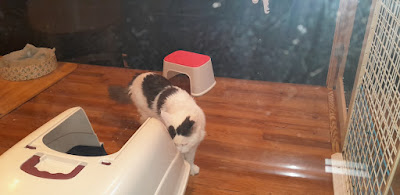Furry Friends and their Lullaby
The weather
got cold, and I missed my furry friends, cats again. We went to a local cat
café to meet furry cuties.
And to talk
about cat, purring is the most fascinating thing. I remember especially in cold
nights; purring is the best lullaby I have ever heard, a simple low frequency
vibration with repeating beat. Although you can always hear such delightful
sounds whenever you stroke your furry friends, the mechanism of purring has
been surrounded in the mystery. Here, I want to share the efforts of scientists
conducted interesting study to crack secrets of purring.
According to
these studies, our feline friends have pads embedded within their vocal cords,
which add an extra layer of fatty tissue that allows them to vibrate at low
frequencies. The article was published in ‘Current Biology’. Larynx or voice
box (Hereafter I use voice box because this is easier word for laypersons) of
cats doesn’t need any input from the brain to produce purr.
Scientists
involved this research said that their study was very first step to
scientifically explain such phenomena because until now many theories were
devised but they were not tested at all. Scientists have been puzzled because
domestic cats were small, but still can produce the low frequency vocalization
with 20~30 Hz frequency band. As a matter of fact, such low frequencies are
usually only observed in much larger animals like elephants, which have longer
vocal cords.
Now it is
well known that most mammal vocalizations including cat noises such as meowing
and hissing are produced similar way: a signal from the brain causes the vocal
cords to press together, and the flow of air through the voice box causes the
cord to knock against each other hundreds of times per second, producing sound.
This process is called ‘flow induced self-sustained oscillation and is passive
phenomena. Once the vocal cords start to vibrate, no further neural input is
required to keep them going.
In the
1970s, some scientists proposed that purring of cat was different. They
believed that purring is sort of ‘active muscle contraction’ meaning that
domestic cats actively contract and relax their voice box muscles about 30
times per second to purr. The idea, based on measurements of electrical
activity in the voice box muscles in purring cat and has been common
explanation for cat purring ever since.
The new
study challenges this hypothesis. To conduct the work, scientists participated
the research removed the voice boxes from eight domestic cats that had been
euthanized because of terminal disease and were investigated with full consent
of their owners. The scientists pinched the vocal cords together and pumped
warm, humidified air through them. By isolating the voice box this way to
guarantee any sound produced was occurring without muscle contractions or any
input from the brain.
The team was
able to produce purring in all the voice boxes and they were surprised. From
this study, they found out that all eight voice boxes produced self-sustained
oscillation at frequency between 25 and 30 Hz without any active neural
control.
However, in
my opinion, this is the experiment using vocal organs taken out from the
donated cats and real mechanism of purring taking place in living cats could be
different. But it is an interesting result providing some hints of how our
feline friends can sing peaceful and soothing songs for us.






Comments
Post a Comment